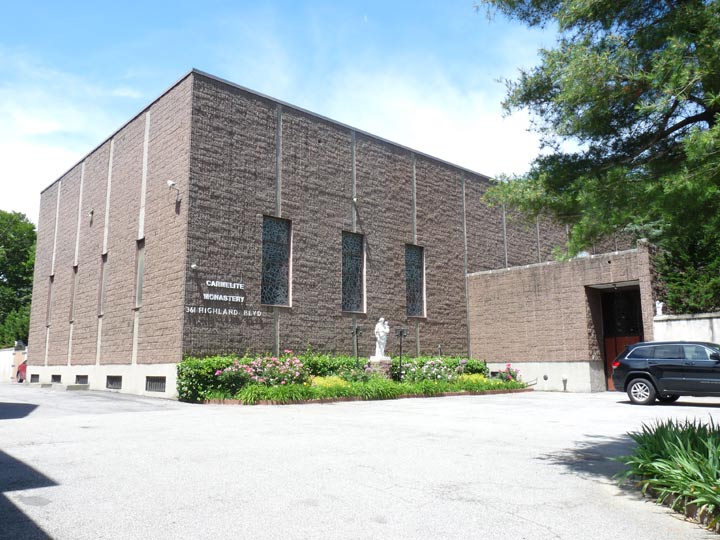Tucked away on Highland Boulevard west of Vermont Place are a pair of somewhat mysterious buildings as well as a stone wall with religious statuary that is topped by barbed wire. The wire is there to discourage invasion from outside, but those within for the most part never leave. The more utilitarian looking of the buildings is the Our Lady of Mount Carmel and Saint Joseph Monastery, which despite its name has no monks inside — rather, the inhabitants are nuns who lead an ascetic existence of no radio, television and few creature comforts; bedding consists of thin foam mattresses which replaced straw just recently. The word discalced means without shoes and the nuns go barefoot or wear sandals. The order does have an internet presence.

The life of a Carmelite Nun is characterized by separation from the world, solitude and silence, manual labor, poverty, penance, detachment from all created things, love for her sisters, and true humility. The life of a Carmelite nun should be a continuous communion with God in prayer and love. Prayer constitutes their specific apostolate and the contribution they make to the Church to collaborate in the redemption; to help Jesus Christ Crucified by their life of prayer and immolation. [Brooklyn Carmel]
According to the Diocese of Brooklyn, the Carmelites were founded in Spain in 1562. Quite obscure even to Catholics, this intensely contemplative order is best known via Francis Poulenc’s strange and brilliant 1957 opera, Dialogues des Carmelites. The Sisters’ previous Brooklyn home, at 745 St. John’s Place in Crown Heights, closed in 1997, its members dispersing worldwide. The monastery was built as a Lithuanian community center in 1974, although other buildings on the property — including a mansion home to Lithuanian Franciscan priests and a three story brick rowhouse housing the offices and printing press for the former Lithuanian weekly newspaper, “Darbininkas” — predate the 1974 building. –Brian Berger, in FNY’s Highland Park Part Two.

Next door is the Pope John Paul II House of Discernment, which is described as a place where young men ages 20-40 believing they may have a vocation to the priesthood study. Similarly, there is a 4-year high school, Cathedral Prep, in Elmhurst, Queens, and there had been a Brooklyn counterpart between 1914 and 1985. Its Flemish Gothic building, now home to condominiums, still stands at Washington and Atlantic Avenues.
Check out the ForgottenBook, take a look at the gift shop, and as always, “comment…as you see fit.”
6/13/19


4 comments
According to their site, admission to the religious order is limited to Catholic women who have never been married and have no children, who are between the ages of 18 and 30, have submitted letters of recommendation, successfully undergo physical and psychological examinations, and are free of debt. Oy vay.
The driveway into the Monastery campus is named on Google Maps and other sources as Robert Place, one of three small lanes north of Highland Boulevard. The others are Heath Place (now a walkway into the park) and Barberry Court. (a dirt road which appears to be a common driveway between two houses) Heath and Barberry are actually signed by DOT. A fourth, Robert Street (on earlier maps part of Crosby Avenue), ran parallel to Highland Boulevard behind the houses and appears to have been obliterated into the landscape of Highland Park.
Robert Street was an alley behind the all of the properties on Highland Boulevard from Heath Place to the monastery. I know this because Kevin had previously posted it at https://forgotten-ny.com/2008/05/highland-park-brooklyn/ 🙂
I am sorry for the Brooklyn diocese for having not been able to appreciate and protect these holy nuns who offered many prayers and sacrifices for them. It is a great loss for that diocese, a sign of the times. My mother’s side of our family is from Brooklyn. I have many good memories of visiting there from upstate but it is sadly no longer what it once was.